Comparative Studies on Steel Corrosion Resistance of Different Inhibitors in Chloride Environment: The Effects of Multi-Functional Protective Film
Abstract
:1. Introduction
2. Experimental Programs
2.1. Materials and Mix Proportions
2.2. Sample Preparation
2.3. Test Methods
3. Results and Discussion
3.1. Open Circuit Potentials
3.2. Evolution of Electrochemical Impedance Spectroscopy (EIS)
3.3. Equivalent Electrochemical Circuits Analysis
3.4. Discussion on Corrosion Inhibitors Comparison
3.5. Cyclic Voltammetry (CV) Test Results

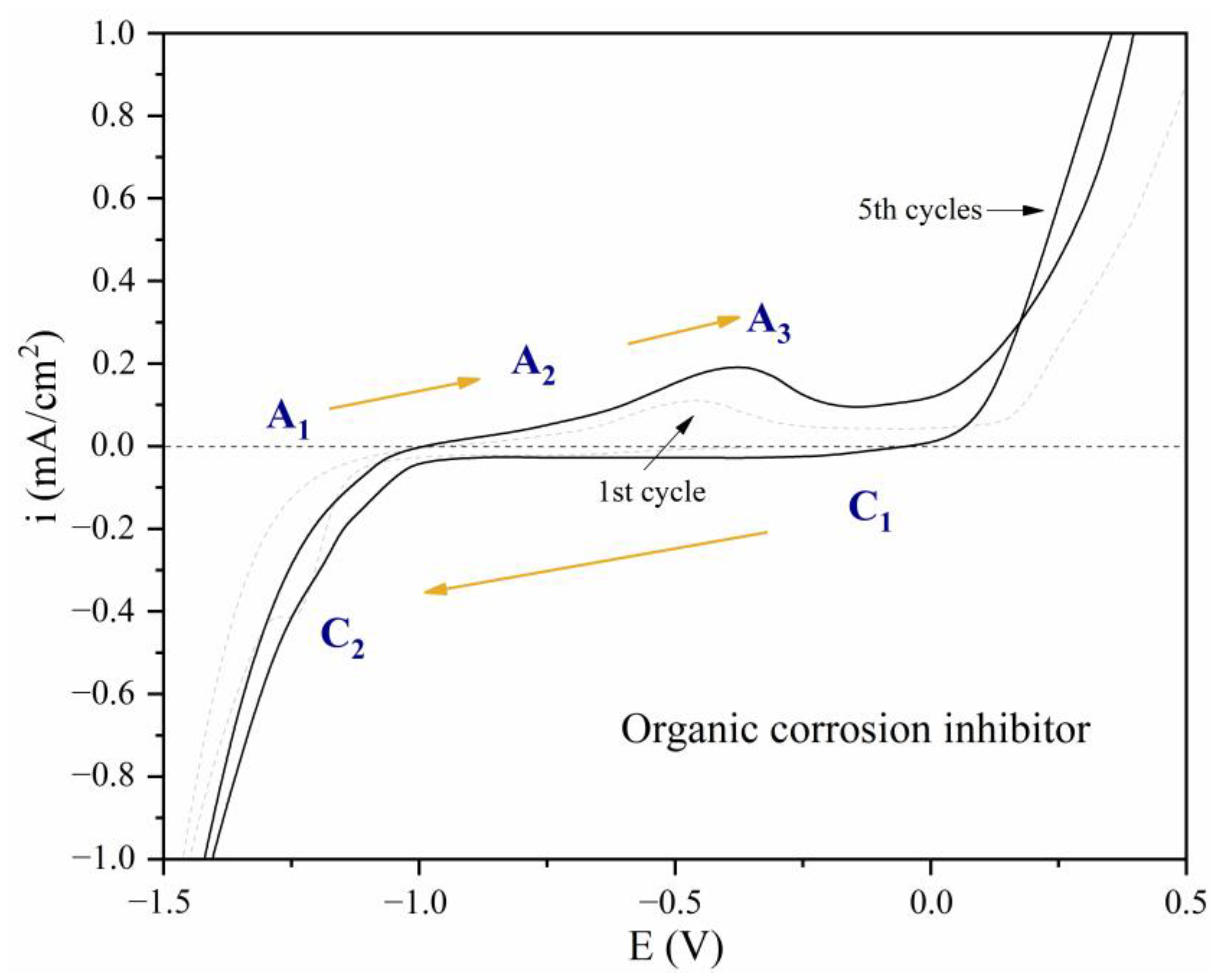

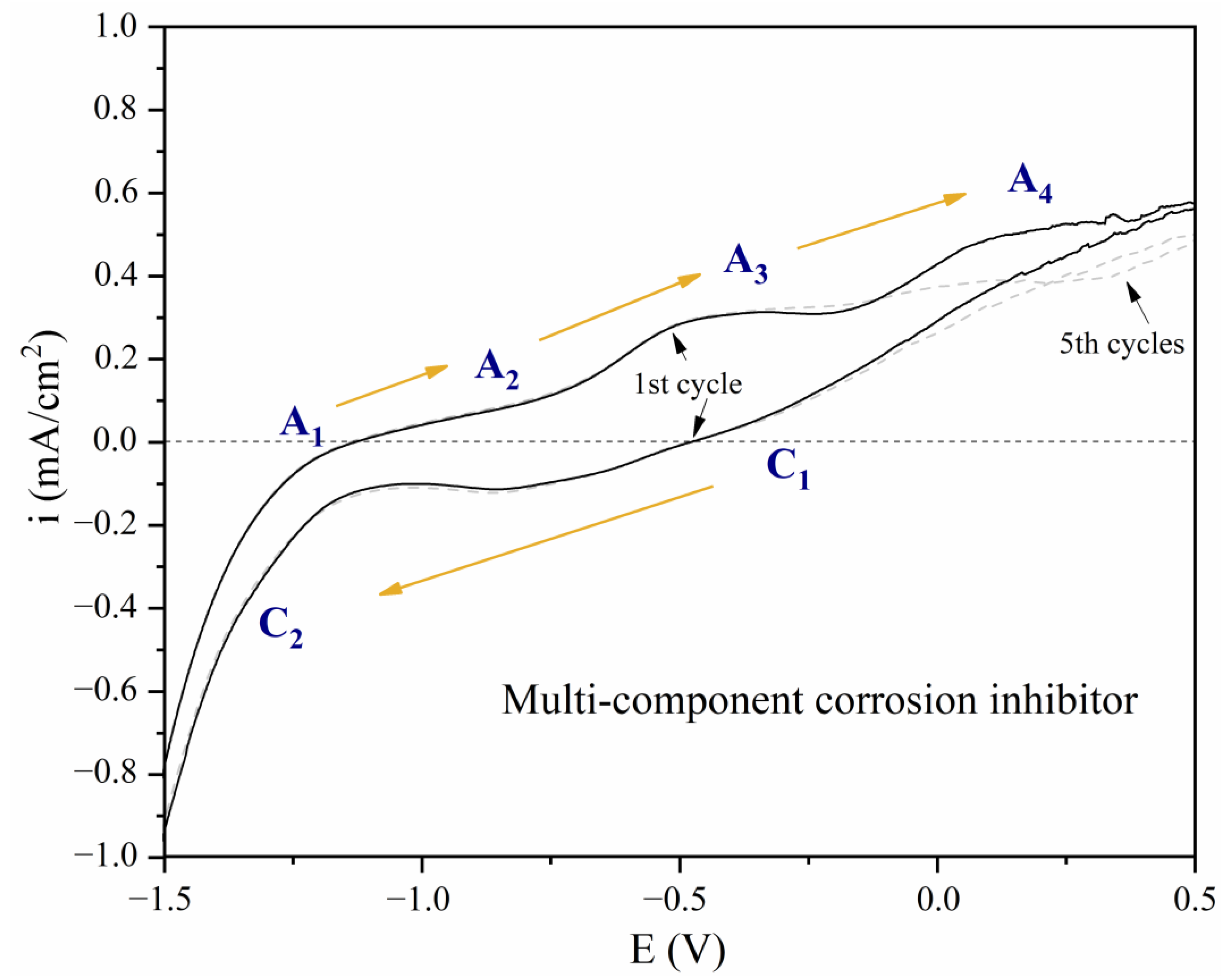
3.6. Micromorphology Observation
4. Conclusions
- (1)
- Multi-component corrosion inhibitors significantly improved the corrosion resistances of steel bars in an SCP solution over a long period (60 days). The open circuit potential reached −0.37 V after 5 days and remained above −0.45 V at 60 days, and its electrochemical impedance spectroscopy reached 730.51 kΩ·cm2 and remained 932.19 kΩ·cm2. As a contrast, the OCP and Rct values of calcium nitrite after 5 days of immersion merely reached −0.28 V and 69.54 kΩ·cm2.
- (2)
- The adsorption and oxidation–reduction reactions that occurred on the steel bar’s surface were comparatively analyzed and experimentally determined by the cathodic potential and the reduction peaks in cyclic voltammetry for the first time. The organic compounds could adhere on steel bar surface, thereby reducing the corrosion current densities in the wide passivation interval of the voltammograms. Additional protective precipitates (FePO4 and Fe2(MoO4)3) formed by the inorganic substance were detected, which contributed to corrosion resistance.
- (3)
- A “multi-functional protective film” was generated by the synergy of organic and inorganic substances, possessing a superiority inhibition effect and serving as a thick barrier. Considering their ideal inhibition efficiency and eco-friendly characteristics, multi-component component corrosion inhibitors could be an ideal substitute and have great application potential for the reinforcement of concrete in a chloride environment.
Author Contributions
Funding
Institutional Review Board Statement
Informed Consent Statement
Data Availability Statement
Conflicts of Interest
References
- Wu, M.; Ma, H.; Shi, J. Enhanced corrosion resistance of reinforcing steels in simulated concrete pore solution with low molybdate to chloride ratios. Cem. Concr. Compos. 2020, 110, 103589. [Google Scholar] [CrossRef]
- Dong, B.; Ding, W.; Qin, S.; Han, N.; Fang, G.; Liu, Y.; Xing, F.; Hong, S. Chemical self-healing system with novel microcapsules for corrosion inhibition of rebar in concrete. Cem. Concr. Compos. 2018, 85, 83–91. [Google Scholar] [CrossRef]
- Wu, M.; Shi, J. Beneficial and detrimental impacts of molybdate on corrosion resistance of steels in alkaline concrete pore solution with high chloride contamination. Corros. Sci. 2021, 183, 109326. [Google Scholar] [CrossRef]
- Xu, P.; Jiang, L.; Guo, M.Z.; Zha, J.; Chen, L.; Chen, C.; Xu, N. Influence of sulfate salt type on passive film of steel in simulated concrete pore solution. Constr. Build. Mater. 2019, 223, 352–359. [Google Scholar] [CrossRef]
- Tian, W.; Liu, Y.; Wang, W. Enhanced ohmic heating and chloride adsorption efficiency of conductive seawater cementitious composite: Effect of non-conductive nano-silica. Compos. Part B Eng. 2022, 236, 109854. [Google Scholar] [CrossRef]
- Sun, H.; Jiang, C.; Cao, K.; Yu, D.; Liu, W.; Zhang, X.; Xing, F.; Zhao, D. Monitoring of steel corrosion and cracking in cement paste exposed to combined sulfate–chloride attack with X-ray microtomography. Constr. Build. Mater. 2021, 302, 124345. [Google Scholar] [CrossRef]
- Wang, H.; Zhang, A.; Zhang, L.; Liu, J.; Han, Y.; Shu, H.; Wang, J. Study on the influence of compound rust inhibitor on corrosion of steel bars in chloride concrete by electrical parameters. Constr. Build. Mater. 2020, 262, 120763. [Google Scholar] [CrossRef]
- Torbati-Sarraf, H.; Poursaee, A. The influence of phase distribution and microstructure of the carbon steel on its chloride threshold value in a simulated concrete pore solution. Constr. Build. Mater. 2020, 259, 119784. [Google Scholar] [CrossRef]
- Jun, Y.; Kim, T.; Kim, J.H. Chloride-bearing characteristics of alkali-activated slag mixed with seawater: Effect of different salinity levels. Cem. Concr. Compos. 2020, 112, 103680. [Google Scholar] [CrossRef]
- Bolzoni, F.; Brenna, A.; Ormellese, M. Recent advances in the use of inhibitors to prevent chloride-induced corrosion in reinforced concrete. Cem. Concr. Res. 2022, 154, 106719. [Google Scholar] [CrossRef]
- Xu, P.; Zhou, J.; Li, G.; Wang, P.; Wang, P.; Li, F.; Zhang, B.; Chi, H. Corrosion inhibition efficiency of compound nitrite with D-sodium gluconate on carbon steel in simulated concrete pore solution. Constr. Build. Mater. 2021, 288, 123101. [Google Scholar] [CrossRef]
- Chen, Z.; Ye, H. Sequestration and release of nitrite and nitrate in alkali-activated slag: A route toward smart corrosion control. Cem. Concr. Res. 2021, 143, 106398. [Google Scholar] [CrossRef]
- Das, J.K.; Pradhan, B. Study on influence of nitrite and phosphate based inhibiting admixtures on chloride interaction, rebar corrosion, and microstructure of concrete subjected to different chloride exposures. J. Build. Eng. 2022, 50, 104192. [Google Scholar] [CrossRef]
- Pan, C.; Chen, N.; He, J.; Liu, S.; Chen, K.; Wang, P.; Xu, P. Effects of corrosion inhibitor and functional components on the electrochemical and mechanical properties of concrete subject to chloride environment. Constr. Build. Mater. 2020, 260, 119724. [Google Scholar] [CrossRef]
- Yang, L.; Ma, Z.; Zheng, Y.; Wang, X.; Huang, Y.; Wang, K.; Song, S.; Jin, W. The study of corrosion behaviors of carbon steel weldments and their inhibition in simulated pore solution using multi-electrode array technique. Appl. Sci. 2021, 11, 8278. [Google Scholar] [CrossRef]
- Shamsa, A.; Barmatov, E.; Hughes, T.L.; Hua, Y.; Neville, A.; Barker, R. Hydrolysis of imidazoline based corrosion inhibitor and effects on inhibition performance of X65 steel in CO2 saturated brine. J. Pet. Sci. Eng. 2022, 208, 109235. [Google Scholar] [CrossRef]
- Shi, J.; Wu, M.; Ming, J. Long-term corrosion resistance of reinforcing steel in alkali-activated slag mortar after exposure to marine environments. Corros. Sci. 2021, 179, 109175. [Google Scholar] [CrossRef]
- Song, Z.; Zhang, Y.; Liu, L.; Pu, Q.; Jiang, L.; Chu, H.; Luo, Y.; Liu, Q.; Cai, H. Use of XPS for quantitative evaluation of tensile-stress-induced degradation of passive film on carbon steel in simulated concrete pore solution. Constr. Build. Mater. 2021, 274, 121779. [Google Scholar] [CrossRef]
- Ashassi-Sorkhabi, H.; Kazempour, A. Incorporation of organic/inorganic materials into polypyrrole matrix to reinforce its anticorrosive properties for the protection of steel alloys: A review. J. Mol. Liq. 2020, 309, 113085. [Google Scholar] [CrossRef]
- Cabrini, M.; Lorenzi, S.; Pastore, T. Cyclic voltammetry evaluation of inhibitors for localised corrosion in alkaline solutions. Electrochim. Acta 2014, 124, 156–164. [Google Scholar] [CrossRef]
- Chen, Z.; Nong, Y.; Chen, Y.; Chen, J.; Yu, B. Study on the adsorption of OH− and CaOH+ on Fe (100) surface and their effect on passivation of steel bar: Experiments and DFT modelling. Corros. Sci. 2020, 174, 108804. [Google Scholar] [CrossRef]
- Guo, Q.; Li, X.; Lin, N.; Liu, J. Influence of Rust Inhibitors on the Microstructure of a Steel Passive Film in Chloride Concrete. Coatings 2022, 12, 692. [Google Scholar] [CrossRef]
- Cui, J.; Yu, D.; Long, Z.; Xi, B.; He, X.; Pei, Y. Application of electrochemical noise (EN) technology to evaluate the passivation performances of adsorption and film-forming type corrosion inhibitors. J. Electroanal. Chem. 2019, 855, 113584. [Google Scholar] [CrossRef]
- Bi, H.; Burstein, G.T.; Rodriguez, B.B.; Kawaley, G. Some aspects of the role of inhibitors in the corrosion of copper in tap water as observed by cyclic voltammetry. Corros. Sci. 2016, 102, 510–516. [Google Scholar] [CrossRef]
- Thomas, B.; Aurora, T. Determination of reaction rate between cathodically formed Fe II-triethanolamine-complex and Fe III-hepta-d-gluconate complex by cyclic voltammetry. J. Electroanal. Chem. 2005, 580, 173–178. [Google Scholar] [CrossRef]
- Frontini, M.A.; Gomez Sanchez, A.; Guidoni, G.M.; Vázquez, M.; Valcarce, M.B. Characterization of surface films on constructional steel in carbonated media containing chloride and nitrite ions. Electrochim. Acta 2020, 364, 137296. [Google Scholar] [CrossRef]
- Cui, L.; Hang, M.; Huang, H.; Gao, X. Experimental study on multi-component corrosion inhibitor for steel bar in chloride environment. Constr. Build. Mater. 2021, 313, 125533. [Google Scholar] [CrossRef]
- Ralkhal, S.; Shahrabi, T.; Ramezanzadeh, B. Synthesis and construction of a highly potent hybrid organic/inorganic anti-corrosive pigment for effective corrosion control of mild steel in simulated seawater. Constr. Build. Mater. 2019, 222, 400–413. [Google Scholar] [CrossRef]
- GB/T1499-2017; Chinese National Standard, Steel for the Reinforcement of Concrete-Part 1: Hot Rolled Plain Bars. Chinese National Standard: Beijing, China, 2017.
- Zhao, Y.; Pan, T.; Yu, X.; Chen, D. Corrosion inhibition efficiency of triethanolammonium dodecylbenzene sulfonate on Q235 carbon steel in simulated concrete pore solution. Corros. Sci. 2019, 158, 108097. [Google Scholar] [CrossRef]
- Qu, L.; Wang, Q.; Xu, S.; Wang, N.; Shi, Z. Chloride corrosion resistance of double-layer anticorrosive coating in simulated concrete pore solution. Constr. Build. Mater. 2021, 295, 123682. [Google Scholar] [CrossRef]
- Qiu, L. Experimental Study on Corrosion Process of Reinforced Concrete in Sulphate-Chlorine Environment; Nanjing University of Science & Technology: Nanjing, China, 2017. [Google Scholar]
- Li, Q.; Su, A.; Gao, X. Preparation of durable magnesium oxysulfate cement with the incorporation of mineral admixtures and sequestration of carbon dioxide. Sci. Total Environ. 2022, 809, 152127. [Google Scholar] [CrossRef]
- Ren, M.; Wen, X.; Gao, X.; Liu, Y. Thermal and mechanical properties of ultra-high performance concrete incorporated with microencapsulated phase change material. Constr. Build. Mater. 2021, 273, 121714. [Google Scholar] [CrossRef]
- Stefanoni, M.; Angst, U.; Elsener, B. Local electrochemistry of reinforcement steel—Distribution of open circuit and pitting potentials on steels with different surface condition. Corros. Sci. 2015, 98, 610–618. [Google Scholar] [CrossRef]
- Verbruggen, H.; Terryn, H.; De Graeve, I. Inhibitor evaluation in different simulated concrete pore solution for the protection of steel rebars. Constr. Build. Mater. 2016, 124, 887–896. [Google Scholar] [CrossRef]
- Chen, M.; Cai, Y.; Zhang, M.; Yu, L.; Wu, F.; Jiang, J.; Yang, H.; Bi, R.; Yu, Y. Novel Ca-SLS-LDH nanocomposites obtained via lignosulfonate modification for corrosion protection of steel bars in simulated concrete pore solution. Appl. Clay Sci. 2021, 211, 106195. [Google Scholar] [CrossRef]
- You, N.; Shi, J.; Zhang, Y. Corrosion behaviour of low-carbon steel reinforcement in alkali-activated slag-steel slag and Portland cement-based mortars under simulated marine environment. Corros. Sci. 2020, 175, 108874. [Google Scholar] [CrossRef]
- Babaee, M.; Castel, A. Chloride-induced corrosion of reinforcement in low-calcium fly ash-based geopolymer concrete. Cem. Concr. Res. 2016, 88. [Google Scholar] [CrossRef]
- Frontini, M.A.; Schreiner, W.; Vázquez, M.; Valcarce, M.B. Nitrite corrosion inhibition in chloride-rich electrolytes correlated to the electrical properties of surface films on carbon steel. Constr. Build. Mater. 2019, 227, 116650. [Google Scholar] [CrossRef]
- Talat, R.; Asghar, M.A.; Tariq, I.; Akhter, Z.; Liaqat, F.; Nadeem, L.; Haider, A.; Ali, S. Evaluating the Corrosion Inhibition Efficiency of Pyridinium-Based Cationic Surfactants for EN3B Mild Steel in Acidic-Chloride Media. Coatings 2022, 12, 1701. [Google Scholar] [CrossRef]
- Li, W.; Jing, J.; Sun, J.; Wang, S.; Zhang, F.; Wang, H. Investigation of the Corrosion Characteristics and Corrosion Inhibitor Action on J55 Steel in Produced Water. Sustainability 2023, 15, 3355. [Google Scholar] [CrossRef]
- Shevtsov, D.; Kozaderov, O.; Shikhaliev, K.; Komarova, E.; Kruzhilin, A.; Potapov, A.; Prabhakar, C.; Zartsyn, I. 3-Sulphinyl-5-Amino-1H-1,2,4-Triazoles as Inhibitors of Copper Corrosion. Appl. Sci. 2019, 9, 4882. [Google Scholar] [CrossRef] [Green Version]
- Sun, C.; Sun, M.; Liu, J.; Dong, Z.; Fan, L.; Duan, J. Anti-Corrosion Performance of Migratory Corrosion Inhibitors on Reinforced Concrete Exposed to Varying Degrees of Chloride Erosion. Materials 2022, 15, 5138. [Google Scholar] [CrossRef]
- Zunita, M.; Wahyuningrum, D.; Buchari; Bundjali, B.; Wenten, I.G.; Boopathy, R. Corrosion inhibition performances of imidazole derivatives-based new ionic liquids on carbon steel in brackish water. Appl. Sci. 2020, 10, 7069. [Google Scholar] [CrossRef]
- Li, P.; Hu, M.; Liu, M.; Zhang, H.; Liu, G.; Xing, Y.; Xia, X.; Guo, J. Thixotropic and hydration effects of Mg/Al-layered double hydroxide and sodium montmorillonite composite dispersion on oil well cement paste. Cem. Concr. Compos. 2022, 134, 104785. [Google Scholar] [CrossRef]
- Fedel, M.; Zampiccoli, M. Insight into the role of cerium (iii) addition to a mgal-ldh coating on aa6082. Appl. Sci. 2021, 11, 8252. [Google Scholar] [CrossRef]
- Karekar, S.E.; Bagale, U.D.; Sonawane, S.H.; Bhanvase, B.A.; Pinjari, D.V. A smart coating established with encapsulation of Zinc Molybdate centred nanocontainer for active corrosion protection of mild steel: Release kinetics of corrosion inhibitor. Compos. Interfaces 2018, 25, 785–808. [Google Scholar] [CrossRef]
- Kartsonakis, I.A.; Stamatogianni, P.; Karaxi, E.K.; Charitidis, C.A. Comparative study on the corrosion inhibitive effect of 2-mecraptobenzothiazole and Na2HPO4 on industrial conveying API 5L X42 pipeline steel. Appl. Sci. 2020, 10, 290. [Google Scholar] [CrossRef] [Green Version]
- Zhou, Y.; Zuo, Y.; Lin, B. The compounded inhibition of sodium molybdate and benzotriazole on pitting corrosion of Q235 steel in NaCl + NaHCO3 solution. Mater. Chem. Phys. 2017, 192, 86–93. [Google Scholar] [CrossRef]
- Poursaee, A. Corrosion measurement and evaluation techniques of steel in concrete structures. In Corrosion of Steel in Concrete Structures; Woodhead Publishing: Cambridge, UK, 2016. [Google Scholar]
- Torbati-Sarraf, H.; Poursaee, A. Corrosion of coupled steels with different microstructures in concrete environment. Constr. Build. Mater. 2018, 167, 680–687. [Google Scholar] [CrossRef]
- Shi, Z.; Shi, C.; Liu, H.; Li, P. Effects of triisopropanol amine, sodium chloride and limestone on the compressive strength and hydration of Portland cement. Constr. Build. Mater. 2016, 125, 210–218. [Google Scholar] [CrossRef]
- Bastidas, D.M.; Criado, M.; Fajardo, S.; La Iglesia, A.; Bastidas, J.M. Corrosion inhibition mechanism of phosphates for early-age reinforced mortar in the presence of chlorides. Cem. Concr. Compos. 2015, 61, 1–6. [Google Scholar] [CrossRef]
- Wu, M.; Ma, H.; Shi, J. Beneficial and detrimental effects of molybdate as an inhibitor on reinforcing steels in saturated Ca(OH)2 solution: Spontaneous passivation. Cem. Concr. Compos. 2021, 116, 103887. [Google Scholar] [CrossRef]
- Matos, J.L.; Cerveira, V.; Manhabosco, S.M.; Valenzuela, S.P.G.; Dick, D.P.; Dick, L.F.P. Humic acid: A new corrosion inhibitor of zinc in chlorides. Electrochim. Acta 2021, 397, 139225. [Google Scholar] [CrossRef]
- Xu, W.; Li, Y.; Li, H.; Wang, K.; Zhang, C.; Jiang, Y.; Qiang, S. Corrosion mechanism and damage characteristic of steel fiber concrete under the effect of stray current and salt solution. Constr. Build. Mater. 2022, 314, 125618. [Google Scholar] [CrossRef]
- Tian, W.; Liu, Y.; Wang, W. Multi-structural evolution of conductive reactive powder concrete manufactured by enhanced ohmic heating curing. Cem. Concr. Compos. 2021, 123, 104199. [Google Scholar] [CrossRef]
- Zheng, H.; Dai, J.G.; Li, W.; Poon, C.S. Influence of chloride ion on depassivation of passive film on galvanized steel bars in concrete pore solution. Constr. Build. Mater. 2018, 166, 572–580. [Google Scholar] [CrossRef]
- Yang, D.; Yan, C.; Zhang, J.; Liu, S.; Li, J. Chloride threshold value and initial corrosion time of steel bars in concrete exposed to saline soil environments. Constr. Build. Mater. 2021, 267, 120979. [Google Scholar] [CrossRef]

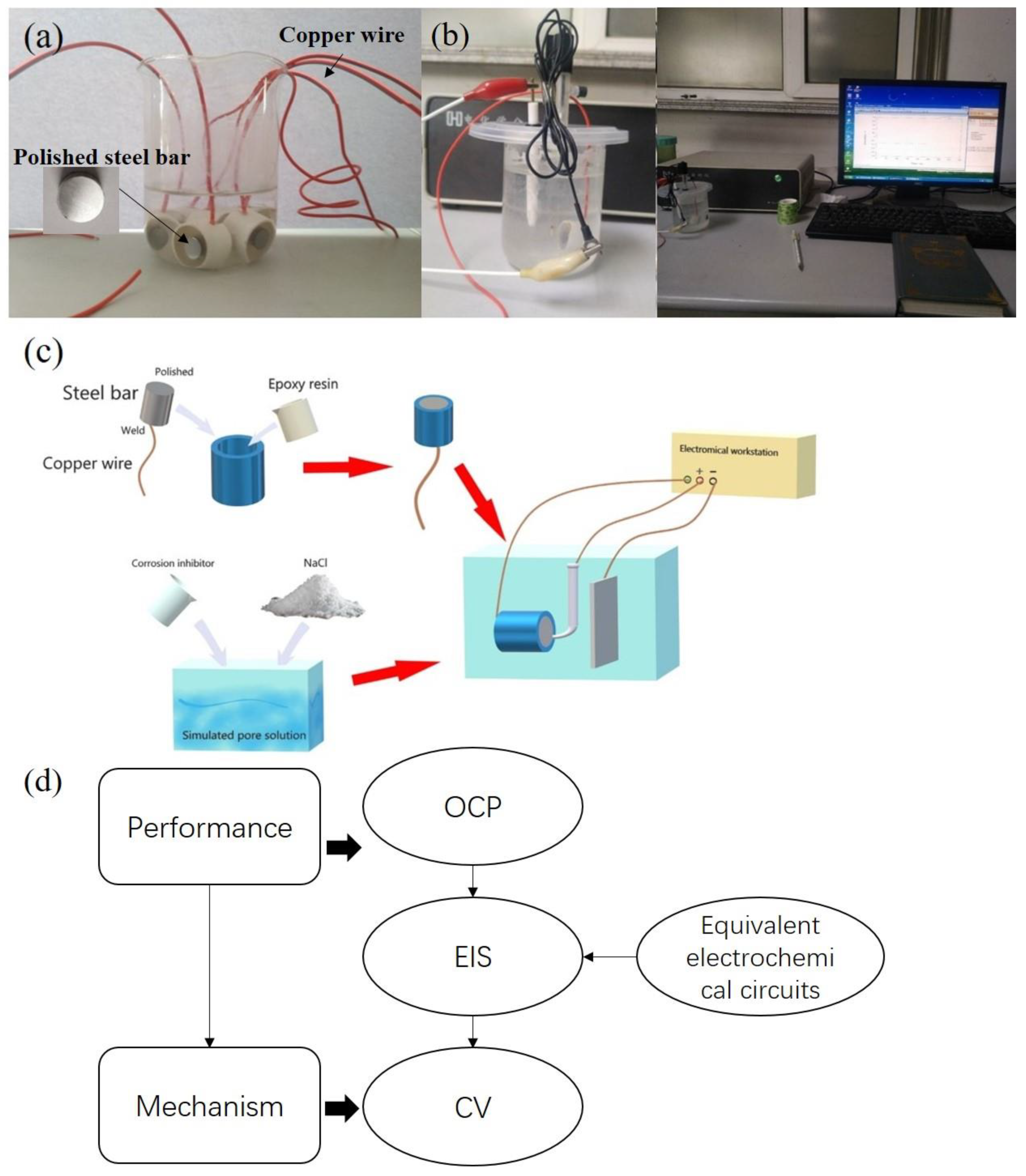
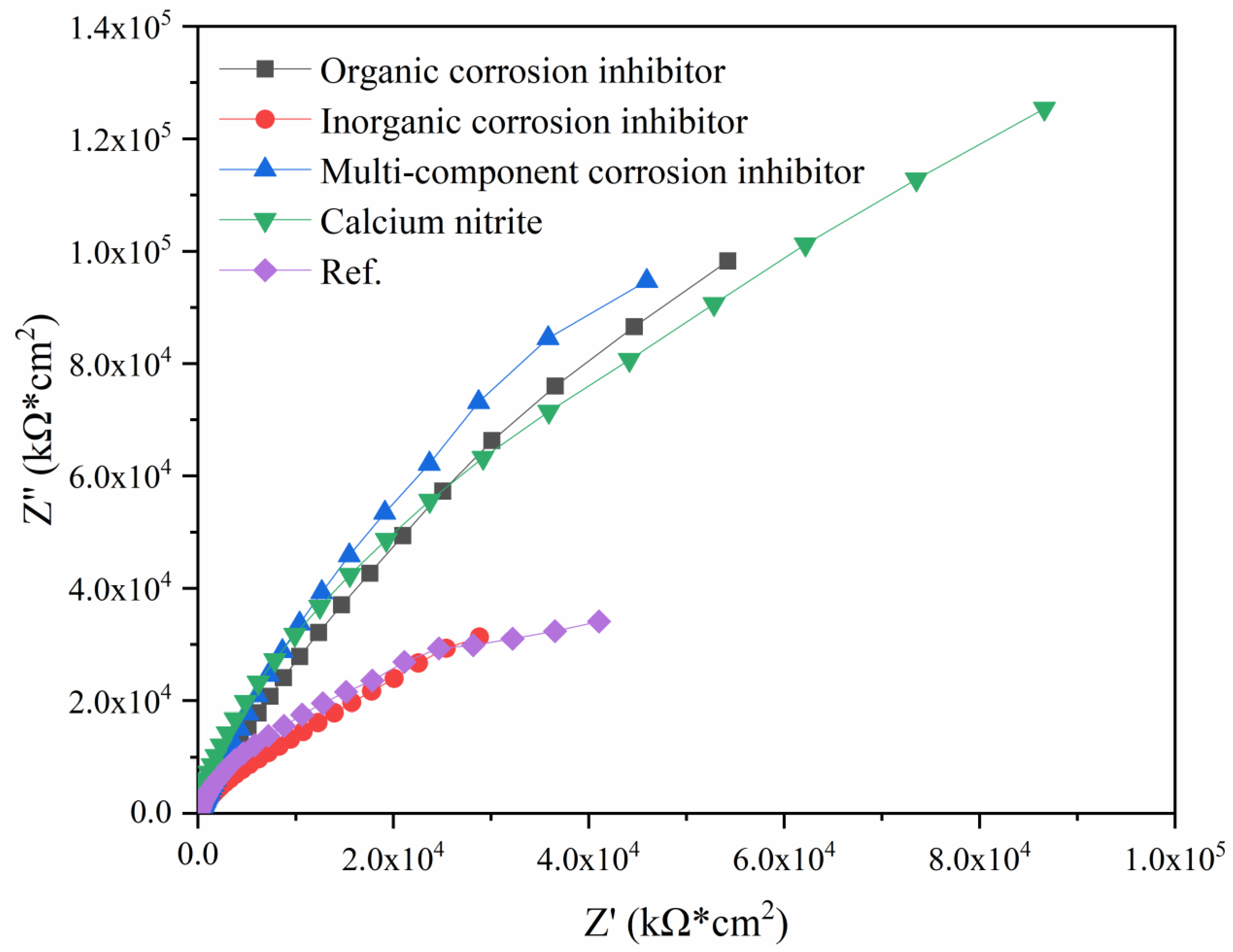
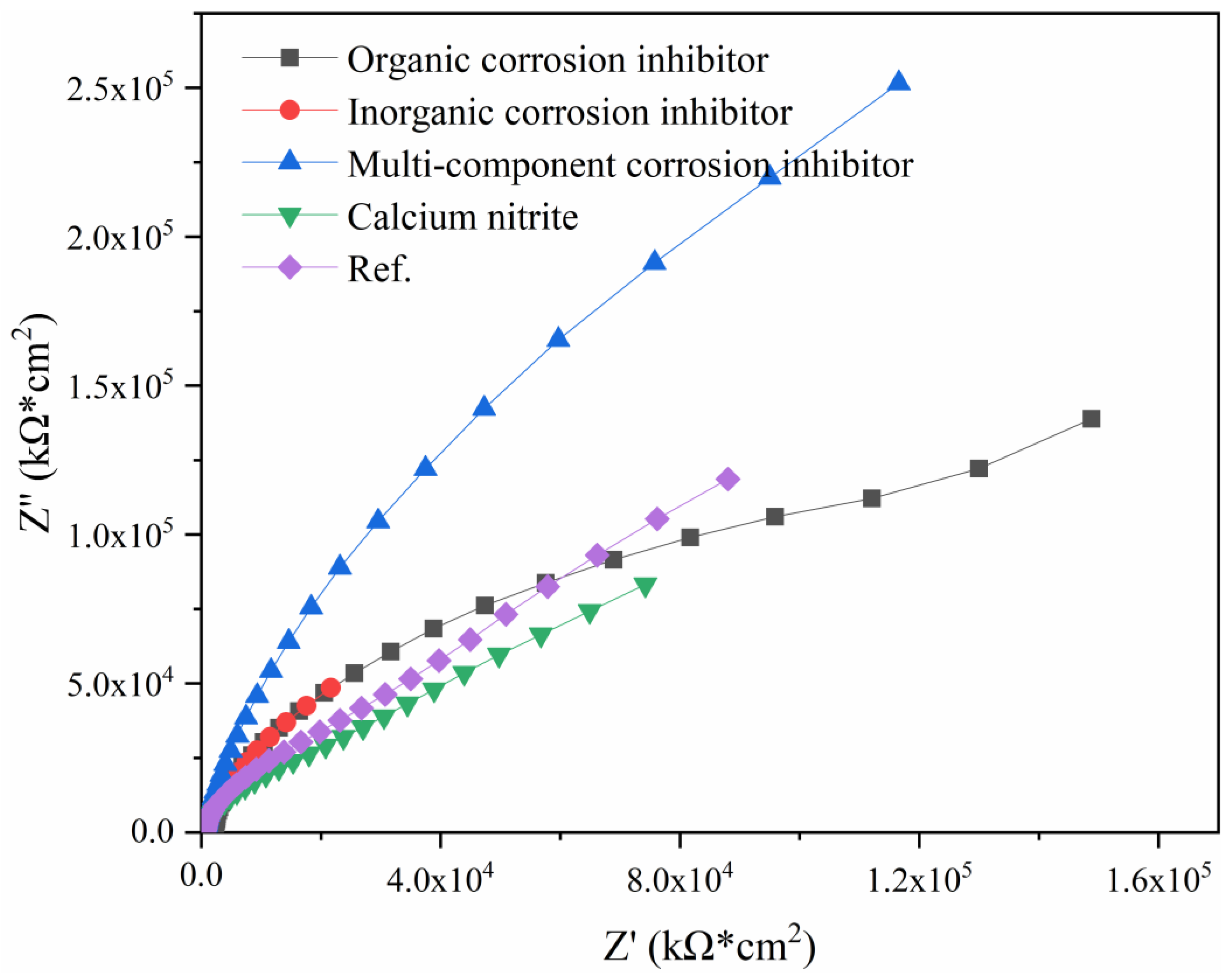
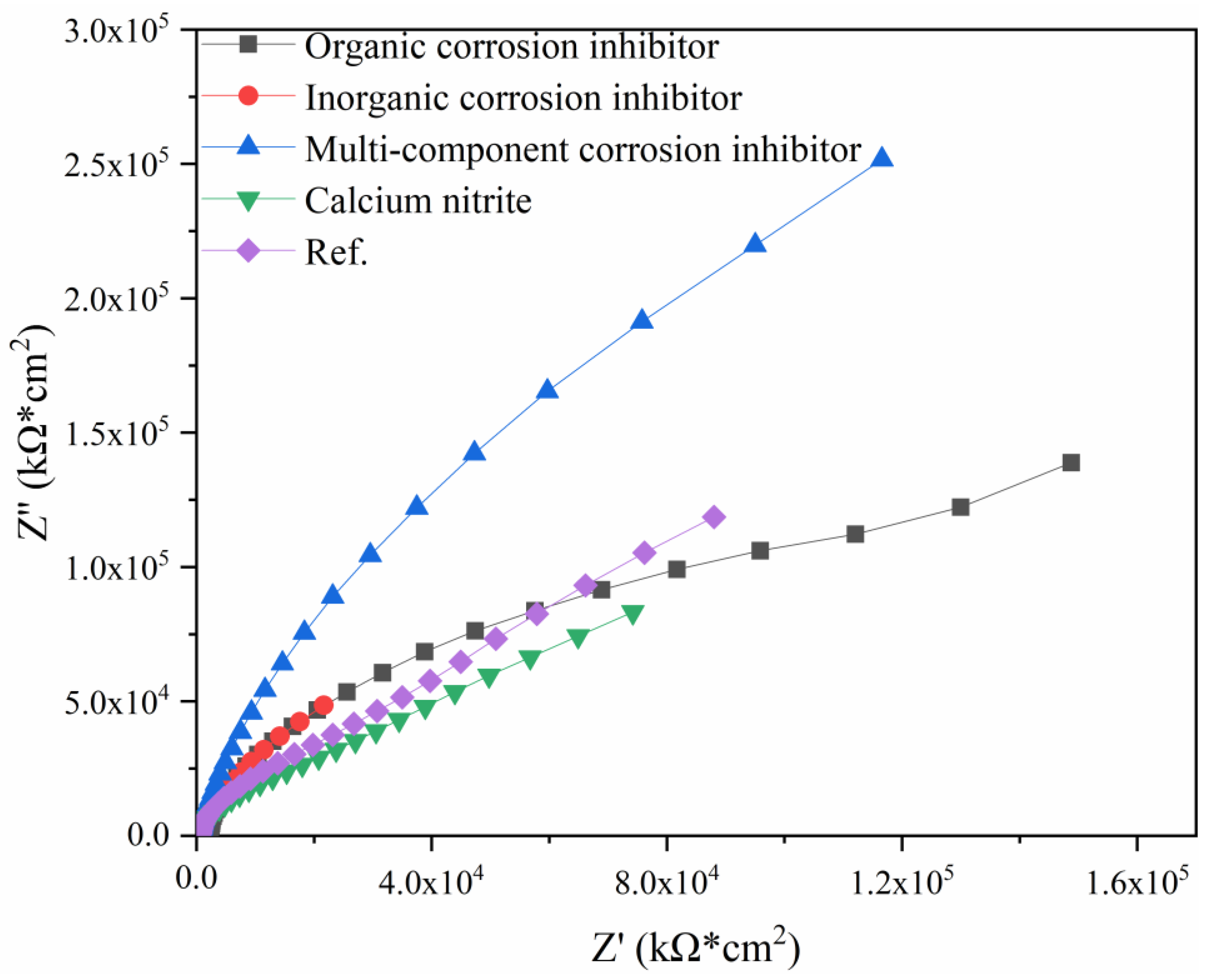
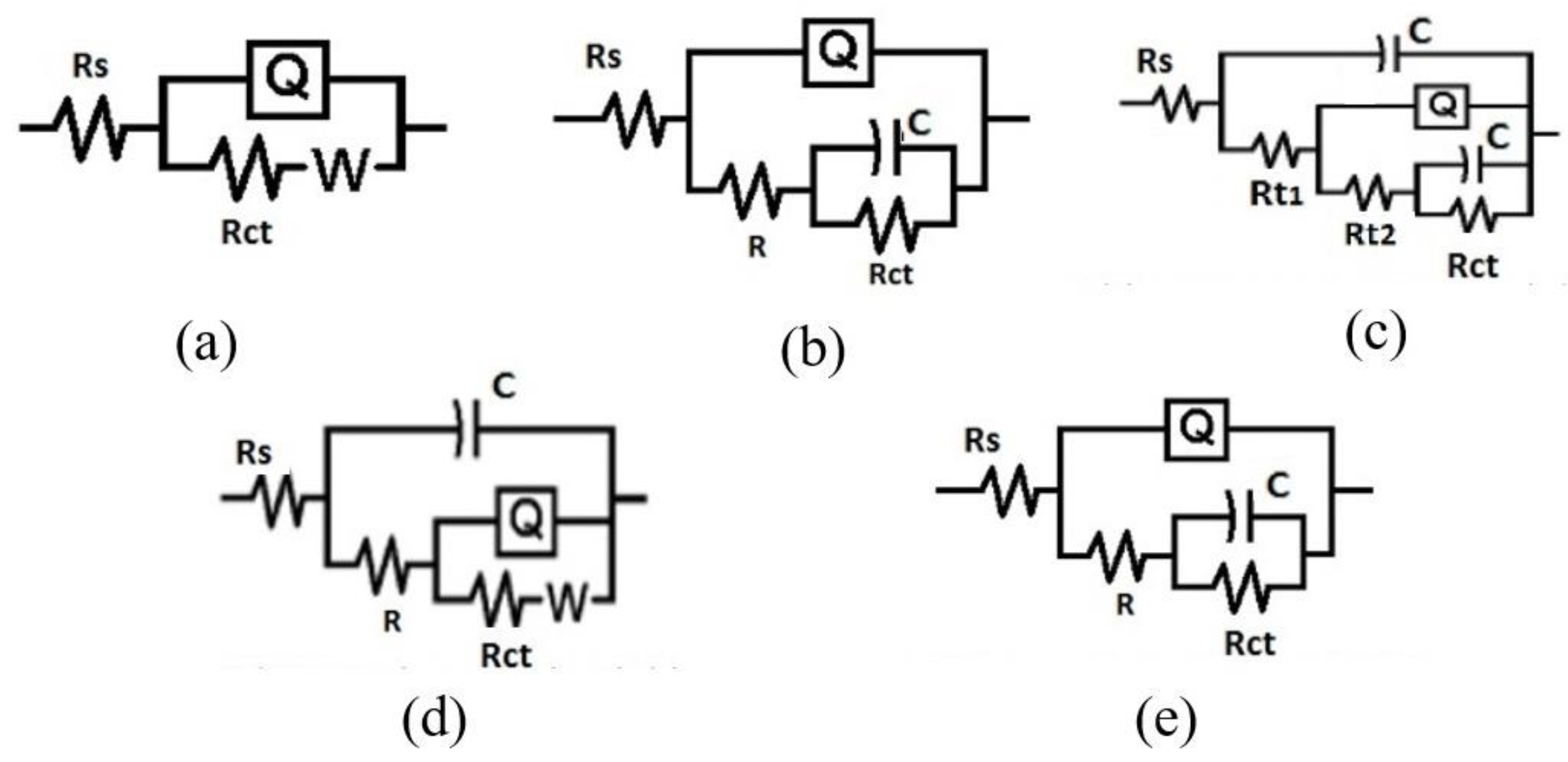
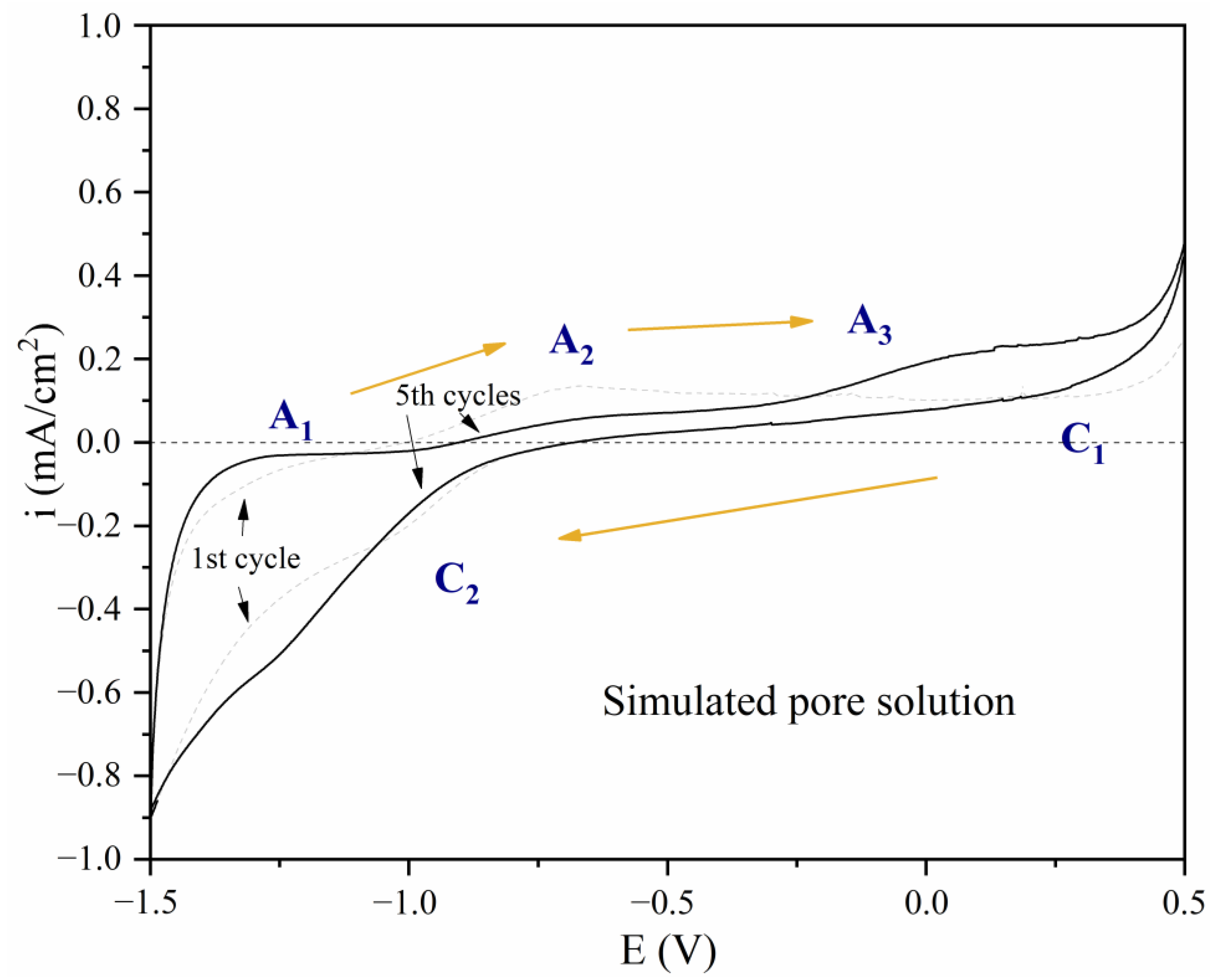
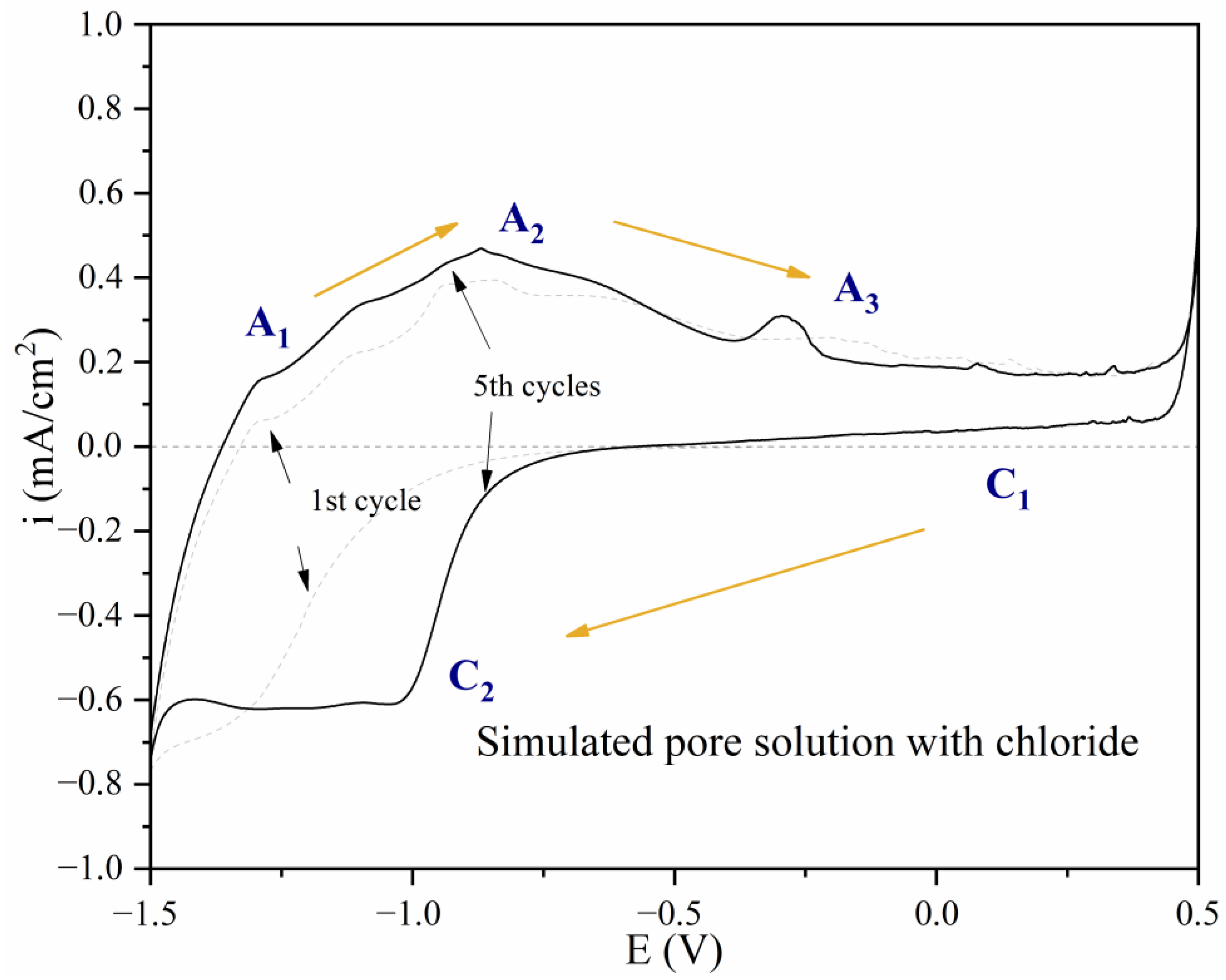
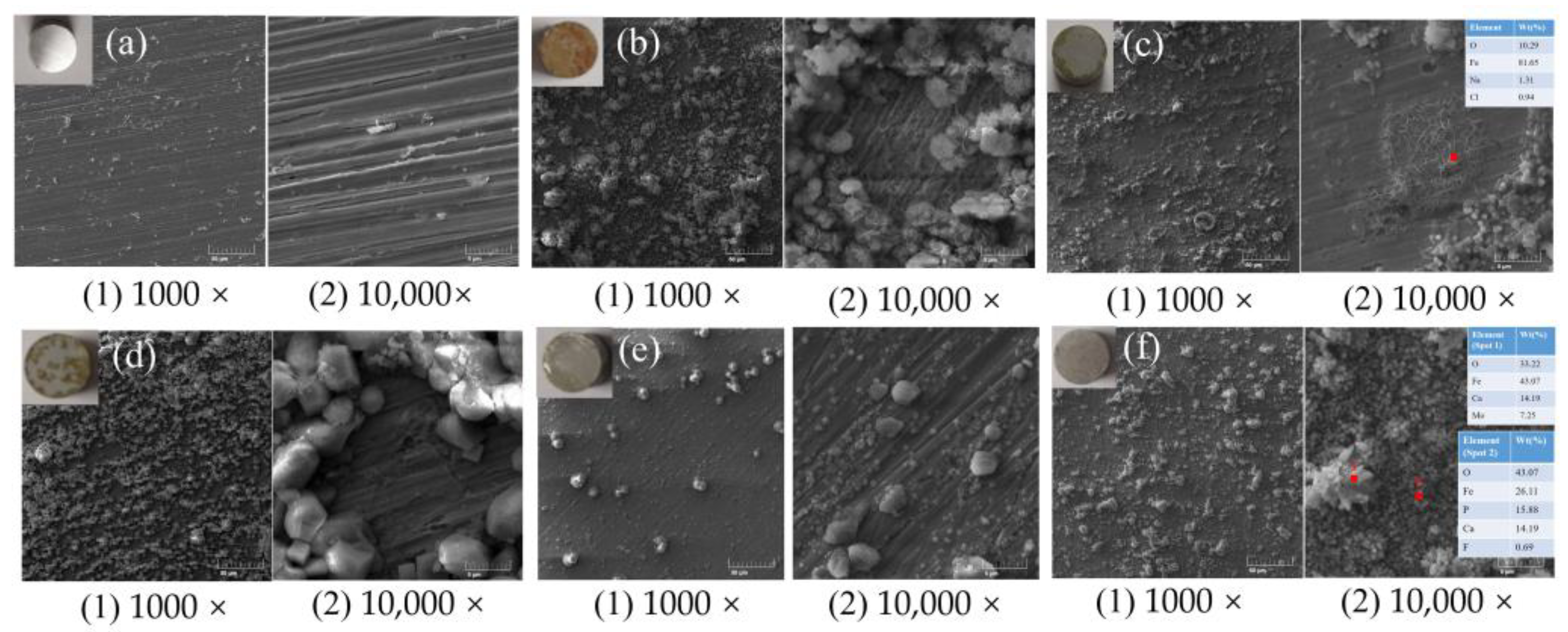
| Element | C | S | P | Mn | Si | Fe | Other |
| Content (%) | 0.192 | 0.024 | 0.012 | 0.580 | 0.355 | 98.370 | 0.467 |
| Specimen | OCP (V vs. SCE) | ||
|---|---|---|---|
| 5 d | 30 d | 60 d | |
| Ref. | −0.23 | −0.22 | 0.12 |
| Calcium nitrite | −0.28 | −0.31 | −0.38 |
| Multi-component corrosion inhibitor | −0.37 | −0.36 | −0.38 |
| Organic corrosion inhibitor | −0.22 | −0.32 | −0.33 |
| Inorganic corrosion inhibitor | −0.39 | −0.4 | −0.45 |
| Specimen | Rct (kΩ·cm2) | ||
|---|---|---|---|
| 5 d | 30 d | 60 d | |
| Ref. | 93.85 | 18.21 | 5.63 |
| Calcium nitrite | 69.54 | 532.22 | 465.17 |
| Multi-component corrosion inhibitor | 730.51 | 1000.01 | 932.19 |
| Organic corrosion inhibitor | 119.26 | 691.15 | 723.38 |
| Inorganic corrosion inhibitor | 123.41 | 52.23 | 48.75 |
| No. | Corrosion Inhibitor | Classification | Cl− Concentration | Test Methods | IE/Best Values | Refs. |
|---|---|---|---|---|---|---|
| 1 | N-(n-octyl)-3-methylpyridinium bromide (Py8) and N-(n-dodecyl)-3-methylpyridinium bromide (Py12) | Organic inhibitor | 3.5% NaCl, pH 1.5 | OCP, Tafel Polarization, EIS | 85.1% (IE) | [41] |
| 2 | Imidazoline | Organic inhibitor | 32.107 g/L NaCl, pH 6.3 | Polarization curve, EIS | 67% (IE) | [42] |
| 3 | 3-sulphinylalkyl-5-amino-1H-1,2,4-triazoles | Organic inhibitor | 1% HCl solution | EIS, Accelerated Corrosion Test, Quantum-Chemical Simulation | 115.01 kΩ·cm2 (Rp, EIS) | [43] |
| 4 | Migratory corrosion inhibitors (MCIs) | Organic inhibitor | 3.5% NaCl, pH 12.3 | EIS, Tafel curve | 9.94 kΩ·cm2 | [44] |
| 5 | Organic compound-based corrosion inhibitor | Organic inhibitor | brackish water | EIS, Tafel curve | 99.3% (IE) | [45,46] |
| 6 | Mg-Al-LDH | Inorganic inhibitor | 0.05 mol/L NaCl + 0.1 mol/L Na2SO4 | FT-IR, OCP, EIS | 832 kΩ·cm2 | [47] |
| 7 | Zinc Molybdate (ZM) encapsulated NPs Stearic | Inorganic inhibitor | 3.5 wt.% NaCl | EIS, PDP | −0.4 V (OCP) | [48] |
| 8 | Na2HPO4–MBT | composite rust inhibitors | 3.5 wt.% NaCl | OCP, linear polarization resistance (LPR), potentiodynamic polarization (PP), XRD | −0.45 V (OCP) | [49] |
| 9 | sodium chromate (Na2CrO4) + benzotriazole (BTA) | Composite rust inhibitors | 8.42 g/L NaCl | XPS, XRD | 96.62% (IE) | [22] |
| 10 | Compound Na2MoO4 + BTA | Composite rust inhibitors | 0.01 mol L−1 NaCl + 0.1 mol L−1 NaHCO3 | OCP, Tafel Polarization, EIS, XPS | 97% (IE) | [50] |
Disclaimer/Publisher’s Note: The statements, opinions and data contained in all publications are solely those of the individual author(s) and contributor(s) and not of MDPI and/or the editor(s). MDPI and/or the editor(s) disclaim responsibility for any injury to people or property resulting from any ideas, methods, instructions or products referred to in the content. |
© 2023 by the authors. Licensee MDPI, Basel, Switzerland. This article is an open access article distributed under the terms and conditions of the Creative Commons Attribution (CC BY) license (https://creativecommons.org/licenses/by/4.0/).
Share and Cite
Cui, L.; Gao, X.; Hang, M.; Chen, T. Comparative Studies on Steel Corrosion Resistance of Different Inhibitors in Chloride Environment: The Effects of Multi-Functional Protective Film. Appl. Sci. 2023, 13, 4446. https://doi.org/10.3390/app13074446
Cui L, Gao X, Hang M, Chen T. Comparative Studies on Steel Corrosion Resistance of Different Inhibitors in Chloride Environment: The Effects of Multi-Functional Protective Film. Applied Sciences. 2023; 13(7):4446. https://doi.org/10.3390/app13074446
Chicago/Turabian StyleCui, Lei, Xiaojian Gao, Meiyan Hang, and Tiefeng Chen. 2023. "Comparative Studies on Steel Corrosion Resistance of Different Inhibitors in Chloride Environment: The Effects of Multi-Functional Protective Film" Applied Sciences 13, no. 7: 4446. https://doi.org/10.3390/app13074446






